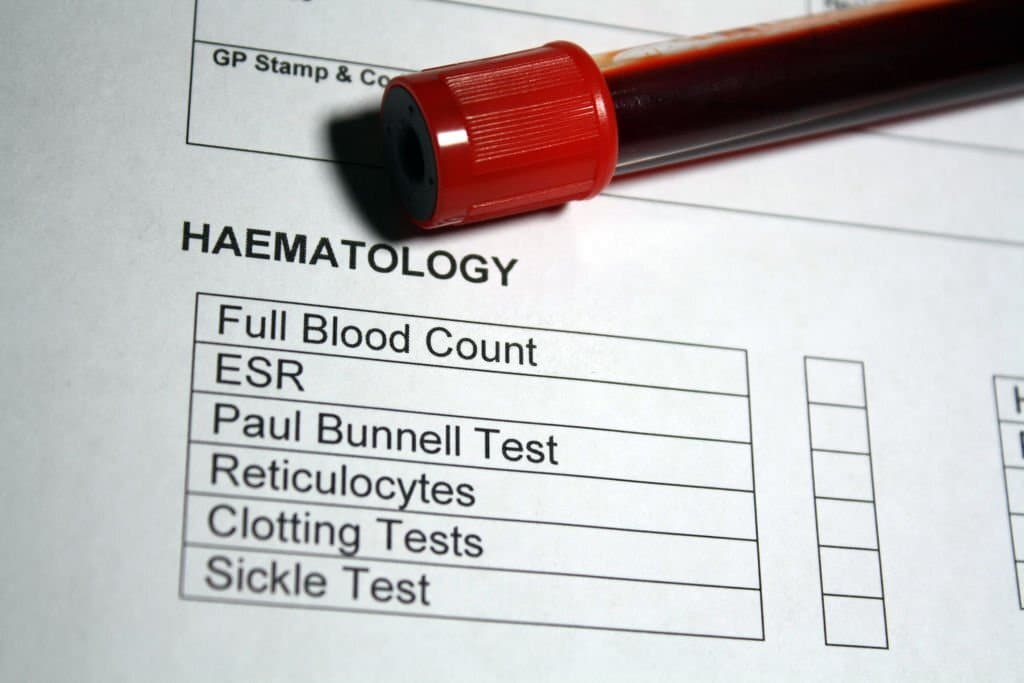ESR Test: Price, Normal Range in Female, Male, & More

Medically Reviewed By
Dr. Ragiinii Sharma
Written By Srujana Mohanty
on Feb 28, 2023
Last Edit Made By Srujana Mohanty
on May 7, 2024

Nowadays, when infectious diseases and inflammatory conditions are prevalent, getting yourself routinely diagnosed is essential to identify abnormalities growing within even before the symptoms appear. One such test that holds immense significance in diagnosing and monitoring a wide range of health conditions is the ESR Test. ESR Test means Erythrocyte Sedimentation Rate Test, which helps look for infections and inflammation early. While often suggested as a part of a routine full-body health checkup, it alone can also serve as a reliable diagnostic test. It measures the rate at which red blood cells settle at the bottom of the tube over a specified period. It is because normally red blood cells sink slowly, but if there is some inflammation or infection present, they stick together in the form of clumps, which sink faster, indicating a problem. While the test doesn’t directly detect a certain medical condition, it serves as a valuable indicator of inflammation or infection in the body, prompting further evaluation. Inflammation is your immune system’s response to certain illnesses, injuries, and medical conditions that may need prompt action.
Your healthcare provider may advise the ESR Blood Test when you have symptoms suggesting a condition that causes inflammation. Getting tested in time is critical to identify the problem early and take charge of your health while there is still time. You can book an ESR Test at Home with Redcliffe Labs, as we provide a doorstep sample collection facility for maximum convenience. So, get tested in time to track changes in ESR levels and manage them with timely intervention.
In this Article
What is an ESR Test?
The test detects the abnormal level of inflammation in the body. The test is not specific to any particular condition but rather serves as a general indicator of inflammation or tissue damage. The test helps to detect infections, autoimmune diseases, blood disorders, kidney diseases, tissue injury or damage, and many health problems.
Test Details:
|
Also Known As |
SED Rate Test, Sedimentation Rate Test, Erythrocyte Sedimentation Rate Test |
|
Purpose |
It helps to detect inflammation & infection and monitor various conditions, including infection, autoimmune disorders, and certain cancers. |
|
Preparation |
Do not drink alcohol or smoke before the test |
|
Fasting |
No Fasting Required |
|
Get Reports Within |
Same Day |
|
ESR Test Cost |
INR 117 |
What is the Purpose of the ESR Test?
It is recommended for several reasons, including:
- Diagnose Infection: ESR can also indicate the presence of infections and is often used with other tests to confirm the diagnosis. Early indication allows for timely diagnosis and better management with minimum complications.
- To Detect Inflammation: While non-specific, it is still a marker of inflammation. It measures the rate RBCs take to settle down in the tube, and elevated ESR levels are usually a sign of inflammation in the body, which could be due to infection, autoimmune disorder, injury, and certain cancers. It may indicate the problem, prompting further evaluation, which helps diagnose the condition early, allowing better management,
- Monitor Certain Medical Conditions: Individuals with known inflammatory conditions, like rheumatoid arthritis or more, can also benefit from the ESR Test, as it helps track any fluctuations in ESR levels to track disease activity and your body's response to treatment over time.
- Assess Certain Cancers: It helps diagnose certain infections and indicates certain cancers. Their monitoring aids in diagnosing and managing these conditions, allowing one to control them.
The ESR Test helps diagnose certain conditions and aids with treatment decisions and management strategies. So, whether your doctor has suggested an ESR Test as a part of a routine health checkup or the test alone, getting tested in time is critical to taking preventive measures.
Symptoms That May Prompt The Need For An ESR Test:
- Unexplained Fatigue: Unusual Persistent Fatigue, even after taking appropriate rest, could also indicate something unusual with your health, prompting further tests to confirm the diagnosis.
- Loss Of Appetite: The sudden change in your eating habits or appetite is also a sign that something might not be right with your health and may need immediate action.
- Respiratory Symptoms: Cold, cough, shortness of breath, or other respiratory-related symptoms indicate some infection or inflammation, prompting the need for an ESR Test and more.
- Chronic Pain or Infection: Unexplained pain or recurrent infection indicates something unusual, prompting an accurate diagnosis to manage the condition well.
- Persistent Fever: If you have an unexplained or recurrent fever without any known cause, it could be a sign of some inflammation or infection, and getting tested in time is critical to confirm the cause and take charge of health in time.
- Joint Pain & Swelling: The unusual pain or stiffness in joints accompanied by swelling could also indicate some inflammatory condition and call for timely action for accurate diagnosis.
While elevated ESR Levels indicate certain medical conditions, they are non-specific markers and may need further examination to find the underlying cause of the symptom and confirm the diagnosis. So, if your doctor has suggested an ESR Blood Test at home, book it with us now.
What does the ESR test measure?
The Erythrocyte Sedimentation Rate (ESR) test measures the rate at which red blood cells (erythrocytes) settle in a vertical blood tube over a certain period. This measurement is a non-specific indicator of inflammation and can provide valuable information about the presence and extent of inflammation in the body.
When inflammation is present in the body, certain proteins called acute-phase reactants (such as fibrinogen and globulins) increase in concentration. These proteins can cause the red blood cells to clump together more easily, making them heavier and increasing their sedimentation rate. This phenomenon is what the ESR test measures. The ESR is typically reported in millimeters per hour (mm/hr), indicating the distance that the red blood cells have settled in the tube over one hour. A higher ESR value indicates a faster rate of sedimentation, which is often associated with increased inflammation or other health issues.
How should I Prepare for an ESR Test?
While it is a simple blood test that may require no special preparations, following certain measures is essential to be prepared and avoid inaccuracies in the test results.
- No dietary recommendations are to be followed, as no fasting is required. However, follow specific instructions your healthcare provider gives to ensure accuracy in the test results.
- Inform your doctor about any medications, be they prescribed, supplements, or herbal remedies you are taking, as they may influence ESR results. So, share it with your doctor and follow their specific instructions.
- Drinking adequate water and staying hydrated is also essential, making it easier for healthcare providers to draw blood.
- Try to remain calm or relaxed before and during the test, as stress can otherwise influence the blood flow and test results, leading to inaccuracies.
- Avoid physical exertion or stress, as these factors can influence the test results.
- If you have any known pregnancy or medical condition, it is always advisable to inform your doctor or phlebotomist before the test and follow their specific guidelines.
If you have any doubts or queries related to ESR Test Preparations, it is always advisable to discuss them with your healthcare provider to ensure accuracy in the test results.
The procedure of the ESR Test
The test involves drawing a blood sample from a vein in your arm. A healthcare professional will clean the area with an antiseptic, place a tourniquet above the area to make the veins more visible, and then insert a needle to collect the blood into a special tube. After the blood is collected, the tourniquet is released, and the needle is removed. Pressure and a bandage are applied to the puncture site to stop bleeding. After testing, the ESR test reports are usually available within a few hours to a day, depending on the laboratory's processing time.
What do the ESR test results indicate?
Interpreting the results of an ESR (erythrocyte sedimentation rate) test involves understanding the significance of the ESR value in the context of your overall health, symptoms, and medical history. ESR above the normal range shows inflammation in the body. However, certain factors can affect the results. The ESR test is commonly ordered when the patient has symptoms of an inflammatory disease. It can also help the physician monitor the effectiveness of treatment. In addition, the test can be used to rule out autoimmune disorders. Your healthcare professional may recommend other tests based on symptoms and physical examination, such as C-reactive protein imaging tests, to identify the cause of elevated ESR levels in the blood.
What is the normal range of ESR in females?
The normal range of erythrocyte sedimentation rate (ESR) is calculated using the Westergren method, considered a gold standard for measuring ESR. In this method, the blood sample is mixed with sodium citrate in a Westergren-Katz tube and is set vertically for one hour at room temperature. After an hour, how far the red blood cells have settled is measured.
The erythrocyte sedimentation rate or ESR normal range test results typically lie between 0 to 20 millimeters per hour. The average reference range for ESR is approximately 1 – 20 mm/h for females. According to the University of Rochester Medical Centre, the normal range of ESR in females at different age groups, when calculated using the Westergren method, is
| S.No. | Age Group (years) | Normal ESR range (mm/h) |
| 1. | < 20 | 0 – 10 |
| 2. | 20 – 50 | 0 – 20 |
| 3. | > 50 | 0 – 30 |
ISO guidelines
What is the normal range of ESR in males?
The average reference range for ESR is approximately 1 – 13 mm/h for males. According to the University of Rochester Medical Centre, the normal range of ESR in males at different age groups, when calculated using the Westergren method, is
| S.No. | Age Group (years) | Normal ESR range (mm/h) |
| 1. | < 20 | 0 – 10 |
| 2. | 20 – 50 | 0 – 15 |
| 3. | > 50 | 0 – 20 |
What happens if the ESR level is abnormal?
The abnormal levels of ESR can indicate different diseases depending upon how much variation there is from the reference range.
Low Levels of ESR
If the level of the ESR are lower than the reference range, it may be an indicator of one of the following health conditions:
- Leukaemia
- Sickle cell anemia
- Congestive heart failure
- High red blood cell and white blood cell count
- Increased blood thickness
- Low levels of the protein fibrinogen
High levels of ESR
If the ESR levels are slightly higher than the normal range, it might indicate one of the following health conditions:
- Anemia
- Rheumatoid arthritis
- Kidney disease
- Thyroid disease
- Lymphoma
- Abnormalities in red blood cells
- Bone infection
- Tuberculosis
- Systemic infection
- Heart infection
If the levels of ESR in your test report are greater than 100 mm/h, it may be an indication of any of the following disorders:
- White blood cell cancer (Waldenstrom’s macroglobulinemia)
- Plasma cell cancer (multiple myeloma)
- Blood vessel inflammation (hypersensitivity vasculitis)
- Temporal arteritis
What is the cause of High ESR levels?
Many factors can contribute to elevated ESR levels. Here are some common causes:
- Infections
- Inflammatory Conditions
- Autoimmune Diseases
- Tissue Damage
- Certain Cancers
- Chronic Kidney Disease
- Pregnancy
- Certain Medications
- Aging
- Other Inflammatory States
Tips to Reduce high ESR level
There are some general tips that might help to reduce the high ESR level.
- Healthy Diet: Eating a balanced and nutritious diet rich in fruits, vegetables, whole grains, lean proteins, and healthy fats can help to reduce inflammation.
- Exercise: Regular physical activity can have anti-inflammatory effects. Start doing exercise daily for better health.
- Stress Management: Stress can worsen the inflammation. Thus, practice meditation, deep breathing exercises, and yoga to manage stress.
- Sleep well: Prioritize your health and get enough sleep.
- Hydration: Drink plenty of water throughout the day.
- Avoid Smoking and Limit Alcohol: Smoking and excessive alcohol consumption can increase inflammation. It's better to limit and quit smoking and alcohol intake to prevent inflammation.
- Regular Checkups: Regular visits to your healthcare provider and ESR tests to monitor your health, track progress, and address any health conditions.
Takeaway
The erythrocyte sedimentation rate (ESR) tells the rate at which your red blood cells settle down when kept at room temperature. The abnormal levels of ESR can be an indication of some underlying health disorders. Now that you know what the reference range of ESR is and what the abnormal levels of ESR may indicate, you can better study and analyze your test report.
Frequently Asked Questions (FAQs)
1. What is the ESR test?
The ESR test is a blood test that measures how quickly red blood cells settle at the bottom of a tube. It is a non-specific indicator of inflammation in the body and is often used to help diagnose conditions like infections, autoimmune diseases, and certain cancers.
2. How can I get my ESR test done?
You can get your ESR test done easily at Redcliffe labs. You can either call our center or book it directly through the official website for booking your test. In both cases, we will send our phlebotomist free of cost to collect your sample.
3. How much will the ESR test cost me?
At Redcliffe labs, we provide the Haemogram test that contains the CBC test and the ESR tests that cost Rs 399/-. However, you can get this test done at Rs 117/- all across India under special discounts.

ESR Test Cost in Different Cities
| City Name | Discounted Price |
| Delhi | ₹117 |
| Noida | ₹117 |
| Mumbai | ₹117 |
| Bangalore | ₹117 |
| Kolkata | ₹117 |
| Pune | ₹117 |
| Lucknow | ₹117 |
| Ahmedabad | ₹117 |
| Hyderabad | ₹117 |
| Chennai | ₹117 |
| Gurgaon | ₹117 |
| Jaipur | ₹117 |
| Faridabad | ₹117 |
| Indore | ₹117 |
| Patna | ₹117 |
4. When can a doctor recommend the ESR test?
Your doctor can recommend you the ESR test if you have one or more of the following symptoms:
- Fever,
- Headache,
- Anaemia,
- Loss of appetite,
- Shoulder or neck pain,
- Joint stiffness,
- Weight loss.
5. Why is the ESR test done?
The ESR test is done to detect inflammation in the body. It helps diagnose various conditions, including infections, autoimmune diseases, and arthritis.
6. What does ESR mean in a blood test?
ESR stands for Erythrocyte Sedimentation Rate, a blood test that measures the rate at which red blood cells settle in a tube. It's a marker of inflammation.
7. What is a high ESR in a blood test?
The high ESR in blood tests indicates an elevated rate of red blood cells settling in a tube. A high ESR value is a nonspecific marker, and further evaluation is needed to determine the precise cause of the high ESR level.
8. How is the ESR test done?
The ESR test is performed by taking the blood sample from the vein in the arm.
9. Can an ESR test detect cancer?
ESR test is not a specific cancer screening test, but it can indicate the presence of inflammation in the body, which might be associated with cancer or other health risks. Further diagnostic tests are needed to confirm a cancer diagnosis if it is suspected based on ESR results and clinical symptoms.
10. Is the ESR test done on an empty stomach?
No, fasting is not required for the ESR test. It can be done at any time of the day, and you can eat or drink as usual.
11. What does the ESR test measure?
The ESR test measures the rate at which red blood cells settle in a tube of blood, which indirectly indicates the level of inflammation in the body.
12. What causes high ESR?
Various factors, including infections, autoimmune diseases, inflammatory conditions, tissue damage, and certain cancers, can cause high ESR.
13. How can I reduce my ESR?
To reduce the ESR level, consult with your doctor and take further testing to confirm the disease. Get proper treatment, adopt a healthy lifestyle with a balanced diet and regular exercise. Reducing stress and avoiding smoking can also contribute to lower ESR levels.
Leave a comment
9 Comments
Muzoalfa
Nov 21, 2023 at 10:34 PM.
im 30 years old female, I recently moved here in UK from Pakistan, I had severe joint pain and stiffness in my all bilateral joints, especially in my lower limb, my all blood test reports are normal except for ESR And CRP both are high with 28mm/hr. I want to ask what is the possible reason behind it, is it might be any rheumatology disease? And plz tell me what should I do now. I'm extremely worried and in severe pain and stiffness.
Myhealth Team
Nov 23, 2023 at 1:25 PM.
High ESR and CRP suggest inflammation. Consult a healthcare professional for a thorough evaluation. Consider pain relief and anti-inflammatory medications. Share your medical history for accurate diagnosis and treatment. Seek urgent medical attention if symptoms worsen.
VINOD KUMAR BAHL
Oct 18, 2023 at 2:32 AM.
VERY GOOD, SUPERB INFORMAION ON ESR. WELL EXPLAINED.
Myhealth Team
Oct 18, 2023 at 6:15 AM.
Thank you for your positive feedback on the ESR explanation.
Sheetal Saha
Oct 1, 2023 at 6:16 AM.
My ESR is 26 is it harmful?
Myhealth Team
Oct 7, 2023 at 9:27 AM.
An ESR of 26 mm/hr is usually within the normal range for adults. Consult your healthcare provider for a complete assessment if you have any concerns or symptoms.
Ojok Alex
Sep 29, 2023 at 3:24 PM.
I learnt something special from this website, thank
Myhealth Team
Oct 7, 2023 at 9:35 AM.
You're welcome! If you have more questions, feel free to ask anytime.
Divya teja
May 31, 2023 at 3:37 AM.
Hi.. My esr is 32 .. And am falling sick.. Does my esr is any reason for my sickness
Myhealth Team
May 31, 2023 at 1:07 PM.
Hi Divya, Thankyou for the enquiry. ESR of 32 mm/hr is slightly elevated and can indicate inflammation in the body. However, it is important to consult with a healthcare professional to determine the underlying cause of your sickness. Your doctor will consider your ESR level along with other factors to provide a proper diagnosis and appropriate treatment.
Ali Kadhim Al-Janabia
May 30, 2023 at 8:17 AM.
Please, is the ESR = 6 low or normal? Thank you
Myhealth Team
May 31, 2023 at 1:08 PM.
Hi Ali, Thankyou for the enquiry. ESR value of 6 mm/hr is often considered within the normal range for adults. However, it's essential to understand that the interpretation of ESR results can vary depending on factors such as the laboratory's reference range and an individual's age, gender, and overall health. It is recommended to consult with a healthcare professional who can evaluate your ESR value in the context of your specific health condition and provide appropriate guidance.
Stalin
May 26, 2023 at 6:49 AM.
Cam you please tell me, What shall I do to maintain ESR normal range?
Myhealth Team
Jun 5, 2023 at 4:55 AM.
Hi Stalin, Thankyou for your enquiry. Maintaining a normal ESR range involves managing the underlying condition causing the elevation. It's important to consult with a healthcare professional who can determine the cause of your elevated ESR and provide appropriate treatment. Managing chronic conditions, adopting a healthy lifestyle with regular exercise and a balanced diet, and following any prescribed medications can help maintain ESR within the normal range. Regular monitoring and follow-up with your healthcare provider are essential for proper management.
Barbara Schriver
Dec 28, 2022 at 4:59 AM.
My ESR rate is 62. What kind of a doctor should I be saying?
Myhealth Team
Dec 28, 2022 at 8:43 AM.
Thank you for your enquiry. You may ask your query on our health community https://redcliffelabs.com/health-community/ and you would receive an appropriate response and along with that you would also receive more content on Health management on this platform.
Karthikeyan
Dec 24, 2022 at 4:19 PM.
Why Erithrocyte sedimentation rate increase in female more than male
Myhealth Team
Dec 26, 2022 at 5:50 AM.
Thank you for your enquiry. You may ask your query on our health community https://redcliffelabs.com/health-community/ and you would receive an appropriate response and along with that you would also receive more content on health management on this platform



